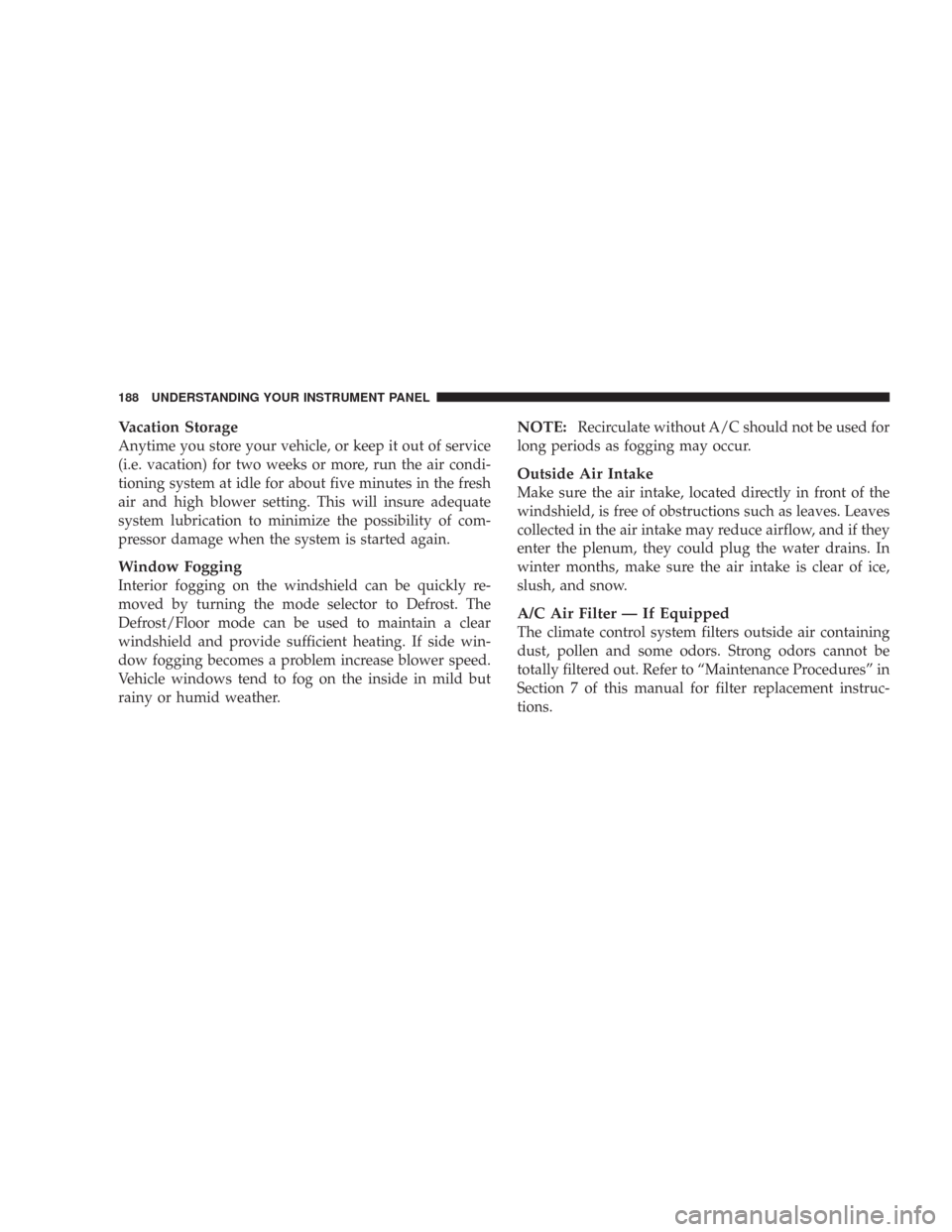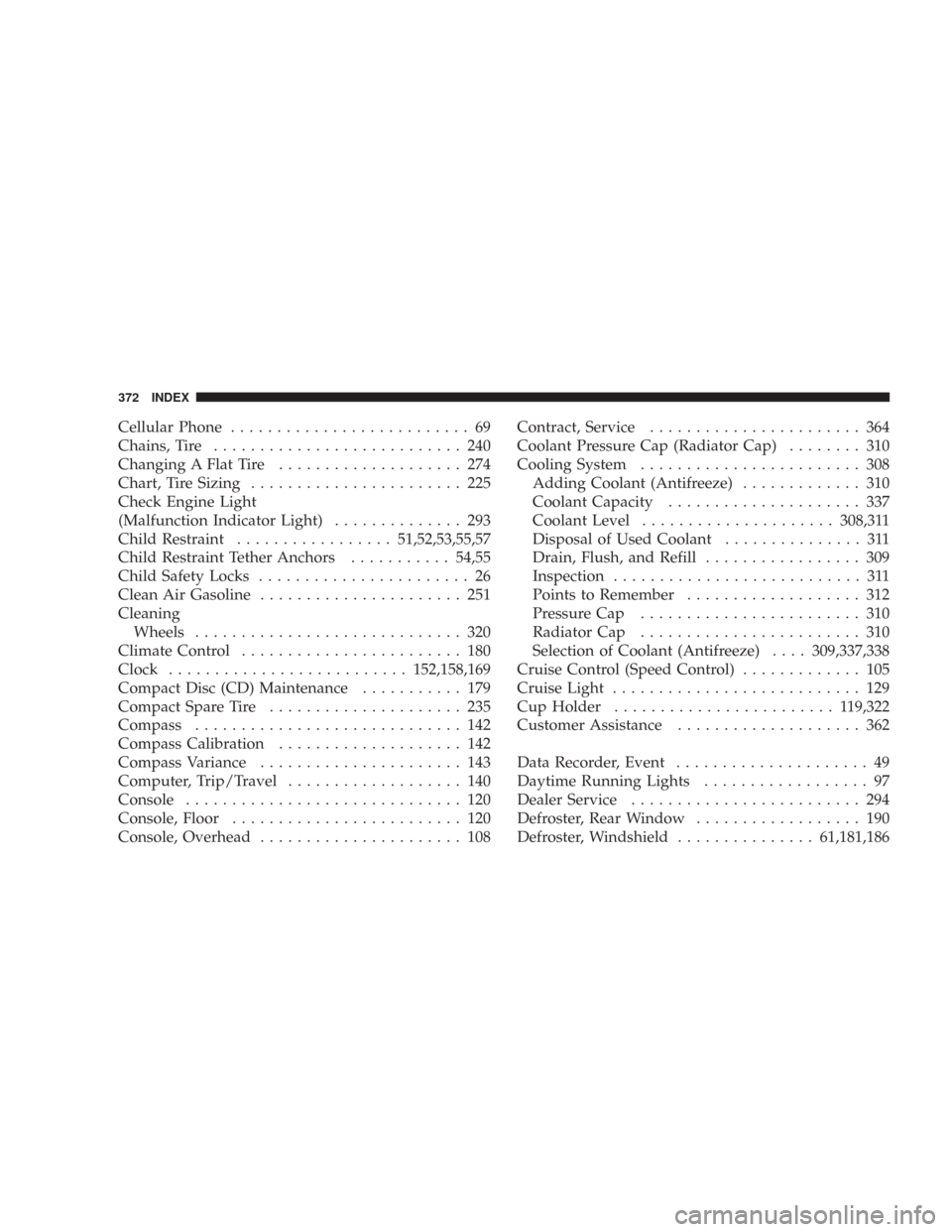Page 188 of 384

Vacation Storage
Anytime you store your vehicle, or keep it out of service
(i.e. vacation) for two weeks or more, run the air condi-
tioning system at idle for about five minutes in the fresh
air and high blower setting. This will insure adequate
system lubrication to minimize the possibility of com-
pressor damage when the system is started again.
Window Fogging
Interior fogging on the windshield can be quickly re-
moved by turning the mode selector to Defrost. The
Defrost/Floor mode can be used to maintain a clear
windshield and provide sufficient heating. If side win-
dow fogging becomes a problem increase blower speed.
Vehicle windows tend to fog on the inside in mild but
rainy or humid weather.
NOTE:Recirculate without A/C should not be used for
long periods as fogging may occur.
Outside Air Intake
Make sure the air intake, located directly in front of the
windshield, is free of obstructions such as leaves. Leaves
collected in the air intake may reduce airflow, and if they
enter the plenum, they could plug the water drains. In
winter months, make sure the air intake is clear of ice,
slush, and snow.
A/C Air Filter — If Equipped
The climate control system filters outside air containing
dust, pollen and some odors. Strong odors cannot be
totally filtered out. Refer to “Maintenance Procedures” in
Section 7 of this manual for filter replacement instruc-
tions.
188 UNDERSTANDING YOUR INSTRUMENT PANEL
Page 190 of 384
REAR WINDOW FEATURES
Electric Rear Window Defroster
The electric Rear Window Defroster Control is
located on the climate control. Press this button to
turn on the rear window defroster and the heated side
mirrors (if equipped). An LED in the button will illumi-
nate when the rear window defroster is ON. The de-
froster automatically turns off after approximately 10
minutes of operation for the first push of the button, and
will turn off after approximately 5 minutes for the second
push of the button.
CAUTION!
To avoid damaging the electrical conductors of the
rear window defroster, do not use scrapers, sharp
instruments, or abrasive window cleaners on the
interior surface of the window.
Labels can be peeled off after soaking with warm
water.
190 UNDERSTANDING YOUR INSTRUMENT PANEL
Page 367 of 384

Treadwear
The treadwear grade is a comparative rating based on the
wear rate of the tire when tested under controlled con-
ditions on a specified government test course. For ex-
ample, a tire graded 150 would wear one and a half (1
1/2) times as well on the government course as a tire
graded 100. The relative performance of tires depends
upon the actual conditions of their use, however, and
may depart significantly from the norm due to variations
in driving habits, service practices and differences in road
characteristics and climate.
Traction Grades
The traction grades, from highest to lowest, are AA, A, B,
and C. Those grades represent the tire’s ability to stop on
wet pavement as measured under controlled conditions
on specified government test surfaces of asphalt and
concrete. A tire marked C may have poor traction perfor-
mance.
WARNING!
The traction grade assigned to this tire is based on
straight-ahead braking traction tests, and does not
include acceleration, cornering, hydroplaning, or
peak traction characteristics.
Temperature Grades
The temperature grades are A (the highest), B, and C,
representing the tire’s resistance to the generation of heat
and its ability to dissipate heat when tested under
controlled conditions on a specified indoor laboratory
test wheel. Sustained high temperature can cause the
material of the tire to degenerate and reduce tire life, and
excessive temperature can lead to sudden tire failure. The
grade C corresponds to a level of performance which all
passenger car tires must meet under the Federal Motor
Vehicle Safety Standard No. 109. Grades B and A repre-
sent higher levels of performance on the laboratory test
wheel than the minimum required by law.
IF YOU NEED CONSUMER ASSISTANCE 367
9
Page 372 of 384

Cellular Phone.......................... 69
Chains, Tire........................... 240
Changing A Flat Tire.................... 274
Chart, Tire Sizing....................... 225
Check Engine Light
(Malfunction Indicator Light).............. 293
Child Restraint.................51,52,53,55,57
Child Restraint Tether Anchors...........54,55
Child Safety Locks....................... 26
Clean Air Gasoline...................... 251
Cleaning
Wheels............................. 320
Climate Control........................ 180
Clock..........................152,158,169
Compact Disc (CD) Maintenance........... 179
Compact Spare Tire..................... 235
Compass............................. 142
Compass Calibration.................... 142
Compass Variance...................... 143
Computer, Trip/Travel................... 140
Console.............................. 120
Console, Floor......................... 120
Console, Overhead...................... 108Contract, Service....................... 364
Coolant Pressure Cap (Radiator Cap)........ 310
Cooling System........................ 308
Adding Coolant (Antifreeze)............. 310
Coolant Capacity..................... 337
Coolant Level.....................308,311
Disposal of Used Coolant............... 311
Drain, Flush, and Refill................. 309
Inspection........................... 311
Points to Remember................... 312
Pressure Cap........................ 310
Radiator Cap........................ 310
Selection of Coolant (Antifreeze)....309,337,338
Cruise Control (Speed Control)............. 105
Cruise Light........................... 129
Cup Holder........................ 119,322
Customer Assistance.................... 362
Data Recorder, Event..................... 49
Daytime Running Lights.................. 97
Dealer Service......................... 294
Defroster, Rear Window.................. 190
Defroster, Windshield...............61,181,186
372 INDEX